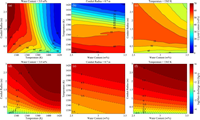Temperature evolution during magma ascent in basaltic effusive eruptions: A numerical application to Stromboli volcano
La Spina G., M. Burton, M. de’ Michieli Vitturi (2015).
Earth and Planetary Science Letters, 15, 89-100, doi:10.1016/j.epsl.2015.06.015.
Abstract
The dynamics of magma ascent are controlled by the complex, interdependent processes of crystallisation, rheological evolution, gas exsolution, outgassing, non-ideal gas expansion and temperature evolution. Temperature changes within the conduit, in particular, play a key role on ascent dynamics, since temperature strongly controls the crystallisation process, which in turn has an impact on viscosity and thus on magma ascent rate. The cooling produced by gas expansion is opposed by the heat produced by crystallisation, and therefore the temperature profile within the conduit is quite complex. This complexity means that unravelling the dynamics controlling magma ascent requires a numerical model. Unfortunately, comprehensive, integrated models with full thermodynamic treatment of multiple phases and rheological evolution are challenging to produce, due to the numerical challenges involved. Until now, models have tended to focus on aspects of the problem, without a holistic approach in which petrological, thermodynamic, rheological and degassing processes, and their interactions, were all explicitly addressed and quantified.
Here, we present a new, multiphase steady-state model for magma ascent in which the main physical and chemical processes, such as crystallisation, degassing, outgassing, rheological evolution and temperature variations, are quantitatively calculated. Basaltic magma’s crystallisation and flow are sensitive to initial temperature and volatile content, and therefore we investigate temperature variations during magma ascent in a basaltic system with a range of volatile contents. As a test case, we use one of the most well-studied recent basaltic effusive eruptions: the 2007 eruption of Stromboli, Italy.
Assuming equilibrium crystallisation and exsolution, we compare the solutions obtained both with and without an isothermal constraint, finding that temperature variations within the conduit have a significant influence on the ascent dynamics and therefore cannot be ignored when modelling basaltic volcanism. Furthermore, we find good agreement between model results and volcanological observations when the non-isothermal condition is assumed. We investigate, through a sensitivity analysis, the role of magma chamber temperature on mass flow rate and crystal content. We find that a temperature variation of 30 K at the base of the conduit has a bigger effect on mass discharge rate than an increase of 1 wt% in water content. Finally, we find that whilst variations in initial CO2 concentration can affect the temperature, pressure and viscosity profiles along the conduit, they do not alter the macroscopic behaviour of the system.
http://www.sciencedirect.com/science/article/pii/S0012821X15003714


